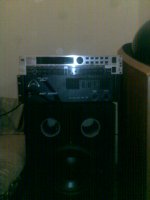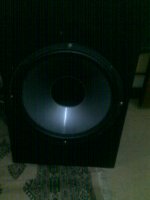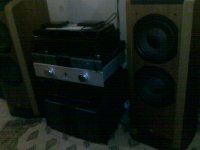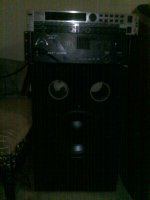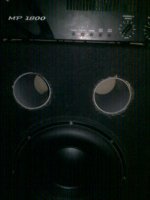Hi, here is my system.
On trial are two subwoofers.
The 12 inch ported is wilson watch dog driver.(for music)
The 15 inch sealed is KEF KARS-380 ,4 drivers available for music/HT.
The amplifier for subwoofer is whardale brdiged for 4 ohm load giving 1800W.
The cross over is set at 60Hz and summed the parametric equalization is 32Hz Q=2 +6 db gain. for ported sub i use 25HZ cut filter. none for sealed.
The KEF is rated 400 W, 130 Oz double stacked magnet Fs=23Hz and efficiency of 95db at 4 ohm. its encolsure is 2.75CuFt . It has a lot of punch way more than wilson which is rather soft despite being tuned at 35Hz.
SO i plan to use 4 KEF 15 inch woofers in two cabinets in pull push combination , magnet back to back creating dipoles and using them in stereo for reduced distortion.
My question is what would be the cabinet size. should it remain the same i.e. 2.7 cuft total 2.5 net or half or double. ?
Secondly does any one have any experience with Whardale , i never expected it to clip which it does occasionaly at significantly loud levels on both subwoofers ( driven altenately) on loud passages as both woofers are rated 400 watts , both are 4 ohm and the amplifier is rated 1800W bridged into 4 ohm.? BTW i intend to replace the whardale with peavey GPS 2600 series driving each cabinet at 2 ohm parallel load of two isobaric subwoofers
On trial are two subwoofers.
The 12 inch ported is wilson watch dog driver.(for music)
The 15 inch sealed is KEF KARS-380 ,4 drivers available for music/HT.
The amplifier for subwoofer is whardale brdiged for 4 ohm load giving 1800W.
The cross over is set at 60Hz and summed the parametric equalization is 32Hz Q=2 +6 db gain. for ported sub i use 25HZ cut filter. none for sealed.
The KEF is rated 400 W, 130 Oz double stacked magnet Fs=23Hz and efficiency of 95db at 4 ohm. its encolsure is 2.75CuFt . It has a lot of punch way more than wilson which is rather soft despite being tuned at 35Hz.
SO i plan to use 4 KEF 15 inch woofers in two cabinets in pull push combination , magnet back to back creating dipoles and using them in stereo for reduced distortion.
My question is what would be the cabinet size. should it remain the same i.e. 2.7 cuft total 2.5 net or half or double. ?
Secondly does any one have any experience with Whardale , i never expected it to clip which it does occasionaly at significantly loud levels on both subwoofers ( driven altenately) on loud passages as both woofers are rated 400 watts , both are 4 ohm and the amplifier is rated 1800W bridged into 4 ohm.? BTW i intend to replace the whardale with peavey GPS 2600 series driving each cabinet at 2 ohm parallel load of two isobaric subwoofers
Attachments
Push pull requires one driver to be inverted, is this what your planning on doing? As for cabinet size, you need to add the same amount of volume to the cabinet every time you add another driver.
Ok. Yes one would be inverted electrically and physically. magnet facing magnet . i intend to reduce foot print of 4 woofer stacking of 15 inches and reduce distortion. These are excellent sounding subs in sealed enclosure . sometimes on some bass notes much better than wilson ported.I intend to increase depth and bit of height but maintaining approximately same width and due to pull push i expect reduced cabinet vibration and therfore a bit relaxation in bracing and weight. > any one used peavey GPS 2600 or Wharfdale 1800 or these woofers ???? the plan is to blend the low end of 802 B&w nautilus with same bass quality due to krell FPB 600
I believe he is talking a P-P Isobaric in a reverse clam-shell (magnet-to-magnet) configuration. The net rear volume would thus be the same as for one driver.
Sounds more like a dual driver sealed sub in a dual opposed configuration to me. The magnets would not face each other in a push pull or an isobaric design.
In a clam-shell Isobaric the drivers are bolted together face-to-face, in the reverse they are magnet-to-magnet. Either way they are P-P.
In a clam-shell Isobaric the drivers are bolted together face-to-face, in the reverse they are magnet-to-magnet. Either way they are P-P.
Thats not push pull though. Push pull requires two drivers to share the same cabinet volume space, and for one driver to face into that cabinet while the other faced out. Then, to ensure the drivers remain mechanically in phase, they are wired out of phase. The isobaric configuration doesnt do this.
Ok. lets not say its pull push. its dual driver in sealed configuration magents facing each other. its more like dipole for reducing distortion and reducing room interaction and to save foot print.
Any one having any idea of KEF KAR S-380 and behringer MP pro 1800 and/or peavey GPS 2600. i am still wondering how the amp clips without the subs bottomin out ?
Any one having any idea of KEF KAR S-380 and behringer MP pro 1800 and/or peavey GPS 2600. i am still wondering how the amp clips without the subs bottomin out ?
Ok. lets not say its pull push. its dual driver in sealed configuration magents facing each other. its more like dipole for reducing distortion and reducing room interaction and to save foot print.
Any one having any idea of KEF KAR S-380 and behringer MP pro 1800 and/or peavey GPS 2600. i am still wondering how the amp clips without the subs bottomin out ?
Just for clarification, push pull works like this:
An externally hosted image should be here but it was not working when we last tested it.
Dual opposed is like this (drivers opposite each other in this cab):
An externally hosted image should be here but it was not working when we last tested it.
Isobaric is like this:

Push pull is the only one that really offers improved distortion reduction over a standard driver config, though how noticeable it is in high end designs is up for debate, I couldnt tell in my own testing unless the subs were really pushed hard. With your clipping issue, its not a given that drivers will be pushed to their mechanical limits when the amp hits its limits. There are drivers out there that when placed in an optimally size enclosure, wont ever hit their mechanical limits, even with their maximum rated input power power available. It sounds like your drivers might fall into that category, assuming your amplifier isnt under rated.
"Thats not push pull though. Push pull requires two drivers to share the same cabinet volume space, and for one driver to face into that cabinet while the other faced out. Then, to ensure the drivers remain mechanically in phase, they are wired out of phase. The isobaric configuration doesnt do this. "
The 2nd harmonic cancellation is what defines P-P, and from that standpoint, yes, you can make a P-P isobaric.
The original isobaric was done by RCA decades ago, it used a 15 on the front and a 12 behind it. This, of course, could not be made P-P (because the drivers were not identical).
The 2nd harmonic cancellation is what defines P-P, and from that standpoint, yes, you can make a P-P isobaric.
The original isobaric was done by RCA decades ago, it used a 15 on the front and a 12 behind it. This, of course, could not be made P-P (because the drivers were not identical).
So, back to your original question, given what you plan to do (sealed with magnets touching and both drivers facing outward in dipole config) seems to me you need twice the volume.
"Thats not push pull though. Push pull requires two drivers to share the same cabinet volume space, and for one driver to face into that cabinet while the other faced out. Then, to ensure the drivers remain mechanically in phase, they are wired out of phase. The isobaric configuration doesnt do this. "
The 2nd harmonic cancellation is what defines P-P, and from that standpoint, yes, you can make a P-P isobaric.
The original isobaric was done by RCA decades ago, it used a 15 on the front and a 12 behind it. This, of course, could not be made P-P (because the drivers were not identical).
Ye sure iso can be made P-P, and following on from that, dual opposed could also be push pull. The main reason to go Isobaric is to make a cabinet smaller, but its much less efficient as it only really matches single driver performance and needs twice the power, plus your paying for two drivers instead of one.
To help be more specific about the original question, Isobaric would mean a cabinet half the size, for any normal configuration, you have to double the cab volume every time you double the number of drivers. If one driver needs 2.5 cu ft, then every time you add another driver, you need to increase the cabinet volume by the same amount.
@ JMillerDoc, dipole wouldnt work for a subwoofer as in a dipole speaker the drivers are out of phase, which doesnt work for subwoofers.
- Status
- Not open for further replies.
- Home
- Loudspeakers
- Subwoofers
- pull push subwoofer design
